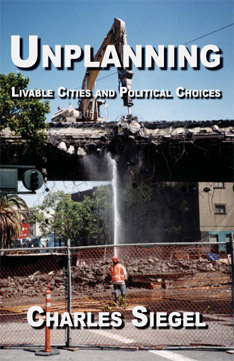
|
||
|
Issue 58 |
|
8 July 2010 |
|
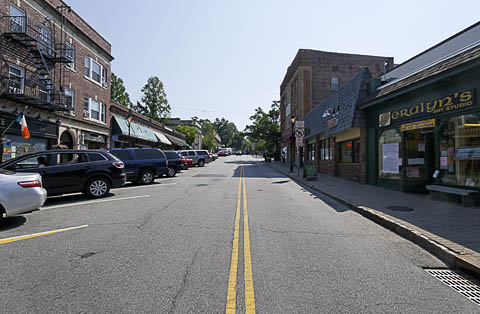 Maplewood, New Jersey None of the SUVs belongs to me. ©2010 J.Crawford AnnouncementsCarfree.com Moves to Maplewood, New JerseyFollowing the deaths of my parents in April and May, I have moved from upstate New York to Maplewood, New Jersey. This is a suburban (!) town about 15 miles (23 km) due west of New York's Greenwich Village. It's the kind of 1920s suburb that people have in mind when they're thinking of moving out of the city. The houses are mostly very attractive, and nearly all are unique. There are large trees everywhere. It's fairly quiet.Maplewood attracted me for some reasons that are relevant to carfreedom. The town is connected by rail directly to mid-town Manhattan at least once an hour from early until late. I live in a small urban village next to the train station. It's a highly diverse place with a strong sense of community. There's real life on the streets. It's much cheaper than New York City. I was able to get rid of the Prius I had been driving for several years as a consequence of having to live in a rural area. My bike is now getting an upgrade. I will be reporting regularly from the front lines of carfree life in suburbia. It's not always going to be easy. The BooksCarfree Cities and Carfree Design Manual are widely available in Europe and North America. Any bookseller in the English-speaking world should be able to order them.World Carfree NetworkCarfree.com actively supports World Carfree Network [WCN]. The main news from the network is as follows.Towards Carfree Cities IX hosted in YorkYork, England, hosted Towards Carfree Cities IX between 28 June and 1 July 2010. I attended and gave a keynote talk focusing on the Reference Design for carfree cities and how it can be adapted to the conversion of existing areas to the carfree model.It was a good conference in a lovely small city with a quarter that dates back to Roman times. It's interesting to note that it appears to have been originally designed using the standard Roman grid plan for colonial cities, but no trace remains of its original form. Two thousand years have left a typical medieval street pattern. There were many interesting talks, most of which will eventually be available on the conference archive web site. Most encouraging was the rapid success of a Sustrans program to get kids back on their bikes for the trip to school. Cycling has a ways to go before it reaches the levels found in the Netherlands and Denmark, but far more kids are riding than just a few years ago, at least in the towns that have asked for help from Sustrans. Kids, it seems, have to be actively deterred from riding their bikes to school. Once the ban is lifted, they turn out in huge numbers. Other presentations that attracted my interest were:
Thursday evening we had permission to close off three blocks of an important street just outside the city walls. The place was jammed with people almost the moment the barricades went up. People were having a great time. The pent-up thirst for street life is obviously huge. Great concern was expressed regarding the current state of the Arctic ice cap. Ice coverage this year is below 2007 for the same date. That was the worst year on record. Alas, the dire situations in the Arctic and the Gulf of Mexico do not seem to have ignited much interest in carfree cities as a solution. Towards Carfree Cities X to be hosted in GuadalajaraJune 2011 will see the first Latin-American edition of Towards Carfree Cities. I met with three of the organizers in York, and they are a committed group intent on doing a version of the conference adapted for a Latin-American audience. Guadalajara is a city of more than four million people. More details here as they become available.Carbusters Now On-LineWCN is releasing a new, on-line version of the venerable Carbusters. Have a look at the Carbusters.org web site. Steadily more of the magazine's content is becoming available on line.
|
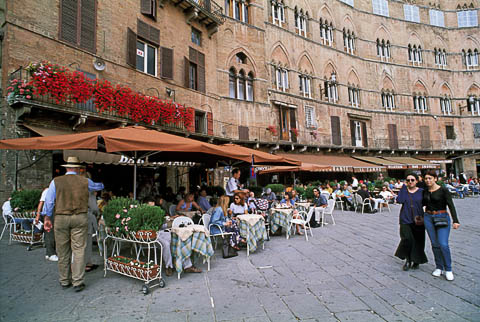 Siena, Italy One of the cafés on the central square. ©1998 J.Crawford CafésWe round off the "sidewalk cafés of Europe" theme in this issue. You could have them in your city. All you need is one carfree street or square.CONTEST: There was no winner of the contest in the last issue. Some people got close. The photographs in issue #56 were all taken with a 2004-vintage digital camera. Those in #57 and this issue were shot on film. Now that I have a newer digital camera that overcomes some of the issues with the first one, I am wholly in favor of digital photography. It is, in nearly every respect, simply better. It's also cheaper and involves fewer toxic chemicals.
News Bits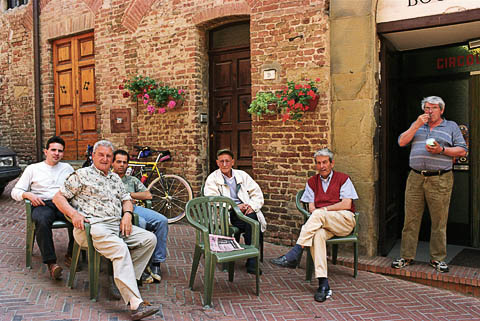 Certaldo Alto, Italy The Italians know a thing or two about enjoying life. That includes cafés. ©1998 J.Crawford Sold Out by Big GreenThe Nation recently published an article that begins, "Why did America's leading environmental groups jet to Copenhagen and lobby for policies that will lead to the faster death of the rainforests - and runaway global warming?" Their lobbyists are behaving as if they were another arm of Big Coal and Oil. What's going on here?Green organizations that ought to be in the forefront of the fight are busy scooping up money from some of the worst polluters. They have abandoned science-based environmental activism. This is the real Climategate. Environmental groups were once funded mostly by their members and supporters. They had a single goal: protect the environment. They didn't have much money, but their role was critical in the passage of many important environmental acts. Then these NGOs realized they could go for the big bucks. Big oil and gas companies are happy to fund conservation groups. In return, they receive awards for "environmental stewardship." Companies like Shell and BP were delighted to buy "reputation insurance." When the oil hits the fan, they point to their shiny green awards to ward off government regulation. At first, this behavior scandalized the environmental community, but slowly other groups saw themselves shrinking as the corporate-fed groups fattened. They, too, swallowed the pill. To give one example, when it was learned that many of IKEA's dining room sets were made from trees cut in endangered forests, the World Wildlife Fund leapt to the company's defense, saying that IKEA "can never guarantee" this wouldn't happen. WWF is a "marketing partner" with IKEA, and takes cash from the company. When the Sierra Club was offered cash to support a supposedly green line of cleaning products, the Club's Corporate Accountability Committee said the deal created a blatant conflict of interest. . . and took the money. In an e-mail to members, the executive director claimed that the organization had conducted an analysis of the cleaners to see if they were "truly superior." But it hadn't. Green groups claim they are improving corporate behavior. But the pressure often flows the other way - addiction to corporate cash has changed green groups. This corrupt relationship has now become the norm in large green NGOs. Johann Hari, the article's author, concludes, "For environmental groups to take funding from the very people who are destroying the environment is preposterous - yet it is now taken for granted." You might expect the American conservation organizations to join the great upsurge demanding we hold atmospheric CO2 to safe levels. The Sierra Club acknowledges on its website that, "If the level stays higher than 350 ppm for a prolonged period of time it will spell disaster for humanity as we know it." Kieran Suckling, executive director of the Center for Biological Diversity, which refuses funding from polluters, has watched this from the inside. He said, "There is a gigantic political schizophrenia here. The Sierra Club will send out e-mails to its membership saying we have to get to 350 parts per million and the science requires it. But in reality they fight against any sort of emission cuts that would get us anywhere near that goal." Why would the Sierra Club oppose measures to prevent environmental collapse? Apparently its leaders now view policy through the lens of what can be pushed through US Senate. They are "politically realistic." Science be hanged. The problem is compounded by the fact that most Democratic senators are accepting huge campaign contributions from the fossil fuel industry. Hari then takes off the gloves: There is a different way for green groups to behave. If the existing political system is so corrupt that it can't maintain basic human safety, they should be encouraging their members to take direct action to break the Big Oil deadlock. This is precisely what has happened in Britain - and it has worked. Direct-action protesters have physically blocked coal trains and new airport runways for the past five years - and as a result, airport runway projects that looked certain are falling by the wayside, and politicians have become very nervous about authorizing any new coal power plants. The more mainstream British climate groups are not reluctant to condemn the Labour government's environmental failings in the strongest possible language. Compare the success of this direct confrontation with the utter failure of the US groups' work-within-the-system approach. As James Hansen has pointed out, the British model offers real hope rather than false hope. . . .Charles Komanoff, who worked as a consultant for the NRDC, says, "We're close to a civil war in the environmental movement. For too long, all the oxygen in the room has been sucked out by this beast of these insider groups, who achieve almost nothing. . . . We need to create new organizations that represent the fundamentals of environmentalism and have real goals." There is some hope. In just a year, 350.org has formed a huge network of activists who are demanding our politicians heed scientific advice. This will be a tough fight, coming just at the moment when our energy ought to be directed against the corporations that are destroying the planet. For a long time I have been saying that the problem in the USA today is that too many institutions are broken all at the same time. If it were only the press, or only the judiciary, or only the legislatures, or only the corporations, it wouldn't be too hard to fix the mess. What I hadn't realized was that Big Green is just as corrupt as anything else. I just gave $100 to 350.org as a tiny antidote to Big Green. Consider doing it yourself if you can.
"The Wrong Kind of Green"  Freiburg, Germany A small café in the pedestrian quarter. ©1998 J.Crawford Rail Systems and US House PricesThe Atlantic is one of the last great magazines that dig deeper into stories than almost any other medium. So, when The Atlantic decides to look at what's going on in the US housing market, it's worth paying attention. Christopher B. Leinberger has a brief but informative article in the June issue. Here's a synopsis.The outer suburbs and exurbs are finished. In the inner suburbs and the city, walkable neighborhoods are the rising star. Leinberger argues that privately-funded rail lines can reinvigorate the housing market, which has really taken it on the chin in the current recession. Housing starts are down 73% in this recession, which is about as bad as it gets. One-third of all jobs lost during the recession were in the housing business (including design, finance, etc.). Housing prices are down 28% since the 2006 peak, the largest decline on record. The red ink isn't evenly distributed, however. If you plot changes in house prices in a typical metro region on a map, the result looks like an archery target. Outlying rings have seen much greater price drops than areas close to the city center. In Washington, DC, for instance, housing prices on average have declined 33% since the peak. But in densely built inner suburbs and walkable neighborhoods inside the District, prices fell about 20%. Out on the edges, however, houses lost about half their value. Many exurban homeowners are now way underwater. The rising costs of driving have further stressed suburban families, who spend 24% of their income on cars; households in walkable neighborhoods spend only 12% of their income on transport. At the same time, the demand for urban living is rising and the demand for exurban housing is falling. The USA may have a surplus of some 22 million large-lot single-family houses by 2025. There is a structural element to today's problem. The oversupply of houses out on the fringes is massive. Many of these houses are now priced below the cost of the materials that went into their construction. Owners have no financial incentive to invest in their houses if they will not get most of their investment back on sale. This is likely to lead to slum-like conditions, even if the tenements are giant houses on large lots. Leinberger sees a problem. Attractive new urban areas take years to develop and require improved infrastructure, especially rail systems. Non-automotive transport infrastructure was all but ignored for decades. We spent the money on roads in the exurbs. And given the state of public treasuries, we have to do it cheaply. His solution: let developers and property owners build and pay for transport infrastructure themselves. This idea is not as daft as it may first appear. In fact, in the 1920s, every US town of more than 5,000 people was served by streetcars, at a time when household income was a third what it is today. Until 1950, people did not need a car to get around; they could use various forms of rail transit. And in 1910 the average household spent only 5% of its income on transport. Real-estate developers and electric utilities built these systems and even paid rent to the cities for the rights-of-way. These lines typically made no money, but they were essential to the development of land a little ways out from the city center. The developers had to subsidize rail service in order to get people to buy the houses in the first place. After WW II, the government was ready to step in and pay for new roads. Transit lines and other infrastructure raise property values. Cities have begun to fund transport improvements by anticipated increases in property taxes. But in most jurisdictions, the additional tax revenue is not enough to pay for rail lines. Perhaps property owners, who stand to benefit from increased values, would be willing to foot the bill. An analysis of a proposed $140 million streetcar line in DC showed that the line would create $3 in land appreciation for every $1 it would cost to build. Up to now, private property owners have been the ones to reap the benefits of investments in new urban rail systems. By creating special-assessment districts, property owners can vote to fund a rail system by charging themselves for it. If a majority of the owners believe they would benefit, all property owners are obligated to help pay for it. In the late 1990s, property owners paid a quarter of the cost of a new rail station in DC in this way. Apparently the investment is being returned manyfold. Leinberger sees many benefits. The infrastructure may seem expensive, but it's actually far cheaper than suburban infrastructure. He gives the figure of one-tenth of the cost per house. Density is the key. Households in walkable urban areas use much less energy. High-density living apparently spurs faster innovation, and in a knowledge economy, ideas come faster and can be developed more quickly if more people can meet easily. Leinberger concludes, "But most immediately, investment in rail, bike, and walking infrastructure, laying the groundwork for developing the kind of housing that is now in demand, is essential if we want to restore the economy to health." I think he has the analysis about right. It's worth noting, though, that the construction of new tram lines a century ago was fast, cheap, and nearly out of control. That led to a lot of overbuilding and subsequent bankruptcy (and service terminations). Today the process is much more complex and also more expensive. Detailed planning is required, and every step must be approved in detail by the city. We may need a return to the more free-wheeling days of yore if we are to induce a flurry of light-rail construction. And my pet project, the short-wire tram, or even battery-powered wireless tram, is perfectly suited to the need. The wires are expensive and ugly. We don't need them.
"Here Comes the Neighborhood" 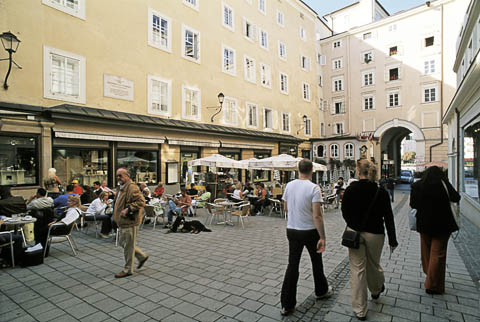 Salzburg This lovely city boasts many cafés. ©2002 J.Crawford Geneva Proposes 200 Pedestrian StreetsThe government of Geneva, Switzerland, recently decided to close 200 streets to cars. This is happening in a city that regularly finishes as a top contender for best place in the world to live. Geneva council member Fabienne Fischer said, "Itís not really to close 200 roads or streets in the center of Geneva, but to open 200 streets to improved life in the neighborhood." The proposal may still be torpedoed by business interests.This is no token change. This is most of downtown. Fabienne said: 200 places for pedestrian life or relationships corresponds to 200 schools, kindergartens, or even every type of people at home. The idea is to concentrate these pedestrian zones near these places in order to protect the more fragile people, older people, younger people. The small shops also need to have a real social life in order to have people coming.You can listen to a brief interview. And I'll be putting Geneva on my agenda for a photo tour.
"Geneva proposes 200 streets as pedestrian only" 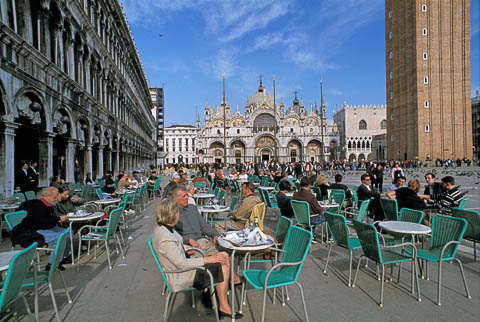 Piazza San Marco, Venice The Campanile towers over the square. ©2001 J.Crawford Hummer No MoreGeneral Motors will shut down its Hummer brand. GM had hoped to sell the brand to a Chinese company, but the sale fell through. Wiser heads must have prevailed. We're sure people everywhere will be sad to see these hulking, gas-guzzling monsters slowly disappear from the road. Hummers weigh up to five tons and are so large it's difficult to see around them. The smoked glass almost universally installed also makes it impossible to see through them. They were emblematic of the worst excesses of the SUV craze.
"GM to end Hummer after Chinese sale collapses" 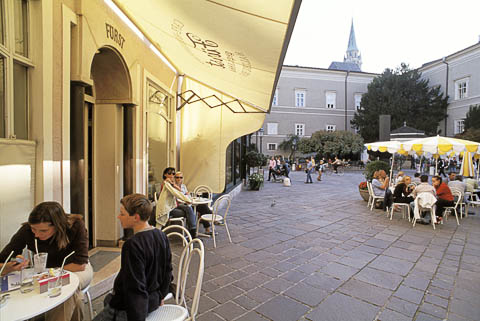 Salzburg The fun-loving Austrians start visiting cafés young. ©2002 J.Crawford Cars Bad for Your Arteries and Probably LungsPeople living within 100 meters of a Los Angeles highway had twice the average progression of atherosclerosis (thickening of artery walls), which can lead to heart disease and stroke. This is the first direct link between automobile and truck exhaust and the progression of atherosclerosis. The study was conducted by scientists from University of Southern California, UC Berkeley, and colleagues in Spain and Switzerland. It was published in the journal PLoS ONE.Researchers used ultrasound to measure the wall thickness of the carotid artery in 1,483 people living within 100 meters of LA freeways. Measurements were repeated every six months for three years. They then correlated their findings with levels of outdoor particulates at the residents' homes. They found that artery wall thickness in study participants increased annually by 5.5 micrometers, which is more than twice the average rate. Study co-author Howard N. Hodis said the findings show that "environmental factors may play a larger role in the risk for cardiovascular disease than previously suspected." Co-author Michael Jerrett noted that "for the first time, we have shown that air pollution contributes to the early formation of heart disease, known as atherosclerosis, which is connected to nearly half the deaths in Western societies. . . . By controlling air pollution from traffic, we may see much larger benefits to public health than we previously thought." Residents of Los Angeles and Long Beach are fighting expansion of the I-710 freeway, saying it would lead to higher rates of asthma, heart disease, and cancer. Now they have some ammunition. In July 2009, the US EPA launched a large study of traffic pollution near Detroit highways to examine whether it causes severe asthma attacks in children. More than one-third of Californians reported that they or a family member suffer from asthma or respiratory problems.
"Study finds traffic pollution can speed hardening of arteries" 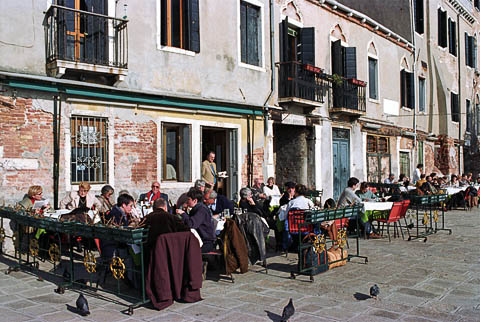 Záttere, Venice South-facing cafés along the water are the most popular in early spring. ©1997 J.Crawford Gravel BatteriesA proposal for gigantic batteries made from gravel might help to compensate for the intermittent nature of renewable electricity production. What has long been needed is some way to store energy when the wind blows or the sun shines, against the need when it doesn't. A solution has been elusive.Until now, the only economically viable way to store large amounts of energy is pumped hydro - excess electricity is used to pump water up hill into a storage dam. When the energy is needed, water is released down hill, spinning turbines and generating electricity. A gravel-based battery could store equivalent amounts of energy but use less space and be cheaper to build. It also doesn't require the hill. The system consists of two silos filled with pulverized rock. Electricity is used to heat and pressurize argon gas that is circulated through one of the silos. By the time the gas leaves the silo, it has cooled to ambient temperature but has heated the gravel to 500°C. The argon is then fed into the second silo, where it is expanded back to atmospheric pressure. This chills the gas and cools the second silo to -160°C. To recover the energy, the cycle is reversed, generating electricity. Heat differences can be stored for extended periods of time. It would take three years for a silo 50 meters tall and 50 meters in diameter to lose half of its energy. (Remember ice houses, which could store ice for an entire year using no insulation more sophisticated than sawdust.) Round-trip energy efficiency is claimed to be a staggering 80%. Gravel is cheap and the system cost per kilowatt-hour of storage would be between $10 and $55. The land occupied by a gravel battery would be less than 1% of the land required for pumped storage of the same capacity. John Loughhead of the UK Energy Research Centre foresees some problems with the system's development. He questions whether the large temperature differences can actually be achieved and has concerns about the effects of rock dust on the machinery. Talks with a large utility company to sponsor a pilot project are in progress. This technology is a game-changer. . . if it works.
"Giant gravel batteries could make renewable energy more reliable" Letter from the Editor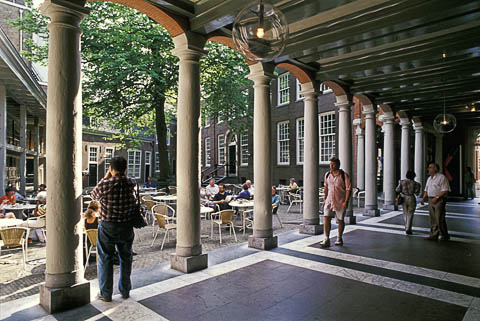 City Museum, Amsterdam An unusual café, located in an interior courtyard. ©1998 J.Crawford On 5 October 2006, my parents were involved in a bad car crash that left my mother on a ventilator for the remaining three-and-a-half years of her life. My father, already suffering from mid-stage dementia, was denied my mother's care for the remainder of his life. They died just two weeks apart, in late April and early May of this year. I was called home from Europe to manage their care during the tumultuous final years of their lives. It was crisis-to-crisis in the first year, settled down to a wearing slog for two more years, and ended with six very difficult months as one medical problem piled on top of another and their suffering became manifest. Thanks to morphine, neither of them suffered intractable pain at the end of life. Otherwise, it was all very difficult to bear on a day-to-day basis. Not all of their difficulties can be ascribed to the car crash, but everything was complicated by it. By far the worst was my mother's dependence on mechanical ventilation to breathe, which also left her unable to vocalize, although she remained able to speak until the very end of her life. Lip reading is, alas, far more difficult than is commonly realized, and communication was extremely tedious. This entire experience has further strengthened my resolve to bring carfree cities to a world in which millions of people die every year from the direct and indirect injury and harm caused by car use. Kicking the cars out of our cities is essential to improving our way of life. I'm back on the job.
Books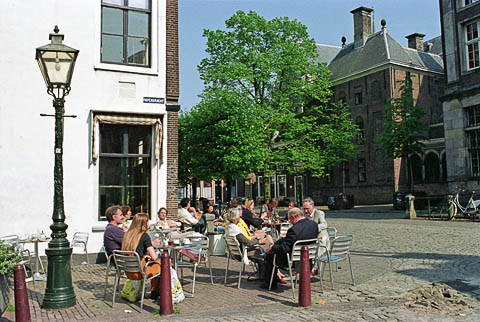 Leiden, the Netherlands A little sun is all it takes to get the Dutch to an outdoor café. ©1998 J.Crawford There is just one new book, but this time it's a full review. I hope to be done with the quick summaries that have been typical these past few years.
The last paragraph of the book is an excellent summary of Siegel's position: The calls for more planning assume that centralized organizations staffed by experts should provide us with goods and services, and ordinary people are nothing more than consumers. This view made some sense one hundred years ago, when scarcity was the key economic problem, but it makes no sense now that over-consumption is the key economic problem in the United States and the other developed nations. Today, we need to invert this technocratic view, so we can change from clients who expect the planners to solve our problems into citizens who deal with these problems ourselves by putting direct political limits on destructive technologies and on growth.This small book parallels many of my own thoughts, although it does not explicitly call for extensive redevelopment of our cities as pedestrian areas. Siegel's "Pedestrian-Oriented City" is not actually carfree but is certainly walkable and would be much more habitable than any arrangement short of the pure carfree model.* see note regarding serious error
Siegel comes loaded for bear when it comes to planners. He identifies two principal schools of top-down urban planning, the Garden-City people like Ebenezer Howard and the Modernists as exemplified by Corbusier. He sees both planning approaches as highly flawed and as having led us into an untenable situation during the 20th century. The planners were "technocrats" and knew too much for us to understand. We had to trust them. It was not until the resistance to freeway construction began to arise in the 1960s that there was any resistance to what was, in practice, an authoritarian model. Yes, the planners were appointed by elected officials, but any attempt to influence their plans for roads, roads, and more roads was largely futile, at least in the beginning. He devotes about half of the book to the well-known failures of centralized planning. He does concede, as do I, that for some tasks, there is no apparent substitute for centralized planning. The provision of drinking water to a metropolitan region or the arrangement of its public transport route network are both examples of tasks that can really only be conducted for the region as a whole. Siegel argues that at a smaller scale, such as a small city or a city district, we shouldn't plan at all. We should set some minimum standards appropriate to the kind of area that is foreseen to develop at the location there and let the market do its thing. All areas would be mixed use, excepting noxious uses. By raising the cost of driving to reflect externalities, the big-box model that dominates the US retail scene today would naturally come to be replaced by more local stores within walking distance for many and short driving distance for everyone else. This is certainly a more workable model than any attempt to sustain the current drive-everywhere-now model that is contemporary America. Siegel thinks that individual demand for various kinds of housing at various densities can yield a balanced supply of housing once the centrally-planned sprawl developments have been basically killed off by internalizing the external costs of the auto-centric model. I go somewhat further in my proposals to let citizens design their neighborhoods directly, working in the field. Siegel stresses the importance of letting people see what plans would look like once built; textual descriptions are inadequate. People will accept much higher densities once they understand what it will look like and that it does not lead to still more driving. I was interested to note how strongly Siegel deals with the noise question. It is one of my own pet peeves about living just about anywhere, even in rural areas if you consider the noise of overflying jets. This is one of the least-considered issues in modern life, yet there is increasing evidence that noise really does kill. For me, the interesting part of the book is Chapter 5 to the end. The initial discussion of the history of centralized planning is quite well known to me. Others may find it more useful. I would recommend this book to anyone interested in an alternative view of the future. It does not achieve all of the benefits of true carfree urbanism, but its goals may be more realistically attainable in the USA.
*Mr. Siegel has kindly pointed out that my reading of his pedestrian-oriented city is just plain
wrong. He's right. We will have more to say about my error at some place and time, probably the
next issue. Note added 16:18 Eastern Time 8 July 2010 with apologies. JHC
Hot New LinksThe links below will open in a new browser window:
On the wrong track: Why high-speed trains are not such a green alternative Emergent Urbanism: Rediscovering urban complexity An Unfinished Freeway Revolt: Car-Free Vancouver Day at StreetsBlog.org Death by Car: capitalism's drive to carmageddon Gang Green blog Affordable-Accessible Housing In A Dynamic City:
About Carfree TimesNext IssueThe next issue of Carfree Times is scheduled for September or October 2010.
Subscribe to Carfree Times
Write for Carfree Times
|
| Editor | J.H. Crawford |
| Send e-mail | |
| URL | http://www.carfree.com/
|
Back to Carfree.com
Carfree Times Home
Back to Carfree Times Issue 57
Forward to Carfree Times Issue 59
E-mail
carfree.com
Copyright ©2010 J.Crawford
